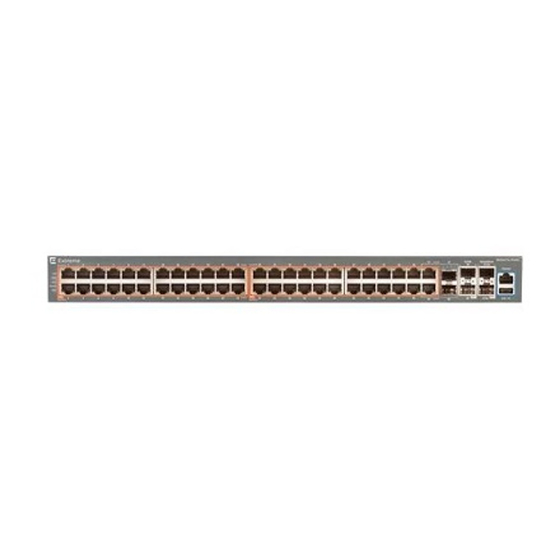Table of Contents
Advertisement
Advertisement
Table of Contents

Summarization of Contents
Chapter 1: About this Document
Purpose
Explains the purpose of the document and the switch series it covers.
Conventions
Discusses the conventions used throughout the guide for clarity.
Text Conventions
Lists text conventions and notice icons used in the document.
Documentation and Training
Provides links to product information and training resources.
Getting Help
Details methods for contacting Extreme Networks support and required information.
Providing Feedback
Explains how to provide feedback to the documentation team for improvements.
Chapter 4: Installation Preparation
Switch Models
Describes the ERS 3600 Series models and their key features.
Universal Serial Bus Ports on the ERS 3600 Series
Explains the function and usage of the USB Type A port.
Electrostatic Discharge Prevention
Provides procedures for preventing ESD damage during the installation process.
Technical Specifications
Details physical specifications for the ERS 3600 Series switches.
Power Specifications
Lists AC power specifications including input power and consumption.
AC Power Cord Specifications
Outlines AC power cord specifications for various international regions.
Verify the Package Contents
Instructs on checking the contents of the shipped package.
Connecting AC Power
Provides steps and safety information for connecting the switch to AC power.
Chapter 5: Installing the Switch
Installing an ERS 3626GTS-PWR+ on a Table or Shelf
Details how to install the switch on a flat surface like a table or shelf.
Installing ERS 3600 in an Equipment Rack
Provides instructions for mounting the switch securely in an equipment rack.
Single and Multiple Switch Arrangements
Explains options for connecting multiple switches in a stack.
Standalone Arrangement
Describes how a single switch can operate independently in a standalone configuration.
Stack Arrangement
Details how to connect switches in a stack using stack connectors.
Understanding Stack Types
Explains how stack order is determined by base unit position and cabling.
Cascade Down
Describes the cascade down configuration for stacking switches.
Cascade Up
Describes the cascade up configuration for stacking switches.
Redundant Cascade Stacking
Explains the benefits of redundant stacking for availability and bandwidth.
Stack Configuration
Covers changing base unit switches and the need for reboot.
Selecting a Base Unit
Details the procedure for designating a base unit in a stack configuration.
Setting Non-Base Units
Explains how to set switches as non-base units in a stack.
Cabling a Stack
Outlines the steps for cabling switches in a stack configuration.
Identifying Cables to use with the Switch
Lists required cables and their specifications for the switch.
Connecting a Transceiver to the Switch or Stack
Describes how to connect SFP transceivers to the switch or stack.
Supported Optical Devices
Lists supported optical devices for high-bit-rate communications.
Small Form-Factor Pluggable (SFP) Transceivers
Details SFPs and their use for gigabit Ethernet links.
Small Form-Factor Pluggable Plus (SFP+) Transceivers
Explains SFP+ transceivers for 10 gigabit connections.
Operating Power Considerations
Discusses optical attenuation when connecting to collocated equipment.
Checking Status LEDs to Verify Switch Installation
Guides on verifying installation and operation using status LEDs.
IP Address Information Configuration
Covers configuring IP address parameters on the switch.
Connecting a Console
Details prerequisites for establishing a console connection.
Accessing the Console Menu
Provides steps to access the switch's console menu.
Assigning IP Parameters Using the Console Menu
Guides on setting IP parameters via the console menu.
Assigning IP Parameters Using Enterprise Device Manager
Explains how to configure IP using the Enterprise Device Manager.
Verifying Assigned IP Address is Reachable
Describes how to verify IP address reachability using ping.
Chapter 6: Installation Reference
Console and Management Connections
Describes front and rear panel connections for switch management.
Console Port
Details the RJ45 console port and its pin-out information.
USB Port
Explains the features and specifications of the USB port.
Chapter 7: Safety Messages
Rack Mounting Safety Precautions
Warns against stacking units directly and stresses using proper mounting brackets.
Appendix A: Regulatory and Compliance Information
Federal Communications Commission (FCC) Notice
States compliance with FCC Part 15 rules for digital devices.
Industry Canada Notice
Notes compliance with Canadian radio noise emissions limits.
Class A ITE Notice
Warns about potential radio interference in residential environments.
Product Safety
Lists product safety compliance standards.
Korea EMC Statement
EMC statement for Korea, indicating it's for business use.
Electromagnetic Compatibility (EMC)
Lists EMC compliance standards for the product.
VCCI Notice
VCCI notice regarding Class A product and domestic environment use.
BSMI EMC Statement — Taiwan
BSMI EMC statement for Taiwan regarding Class A product.
CCC EMC Statement — China
CCC EMC statement for China regarding Class A product.
Battery Warning - Taiwan
Warning about battery explosion risk if replaced incorrectly.
Restriction of Hazardous Substances
Information on RoHS directives for Taiwan and China.
Hazardous Substances
States compliance with EU directive on hazardous substances.
European Waste Electrical and Electronic Equipment (WEEE) Notice
Explains WEEE directive requirements for collection and disposal.
Safety
Lists safety compliance standards.










Need help?
Do you have a question about the ExtremeSwitching ERS 3650GTS and is the answer not in the manual?
Questions and answers